Communications Skills for Business
VerifiedAdded on 2023/01/11
|9
|2808
|39
AI Summary
This report discusses communication models, systems, methods, and technology used in businesses. It also provides tips for making communication effective and identifies barriers to effective communication.
Contribute Materials
Your contribution can guide someone’s learning journey. Share your
documents today.
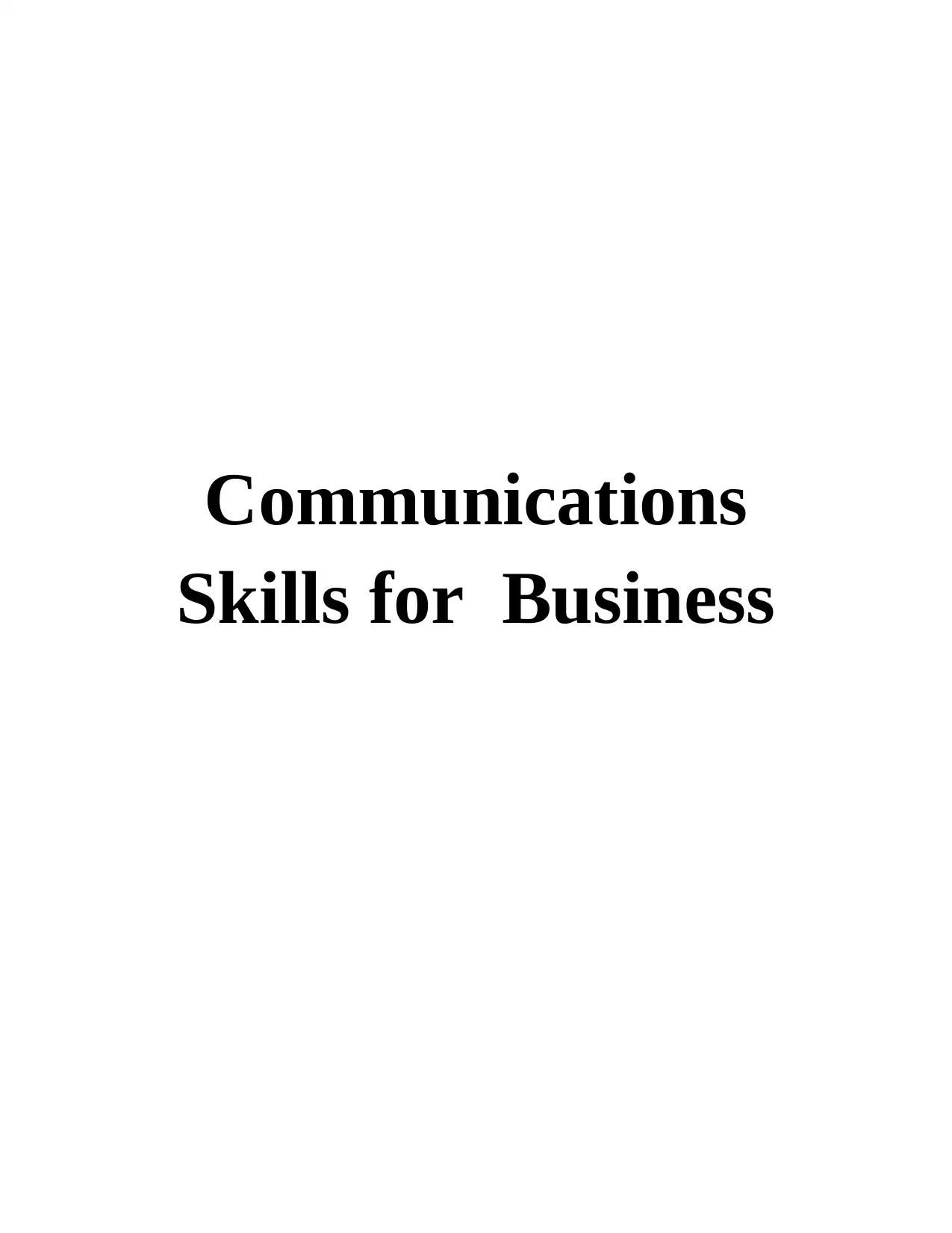
Communications
Skills for Business
Skills for Business
Secure Best Marks with AI Grader
Need help grading? Try our AI Grader for instant feedback on your assignments.
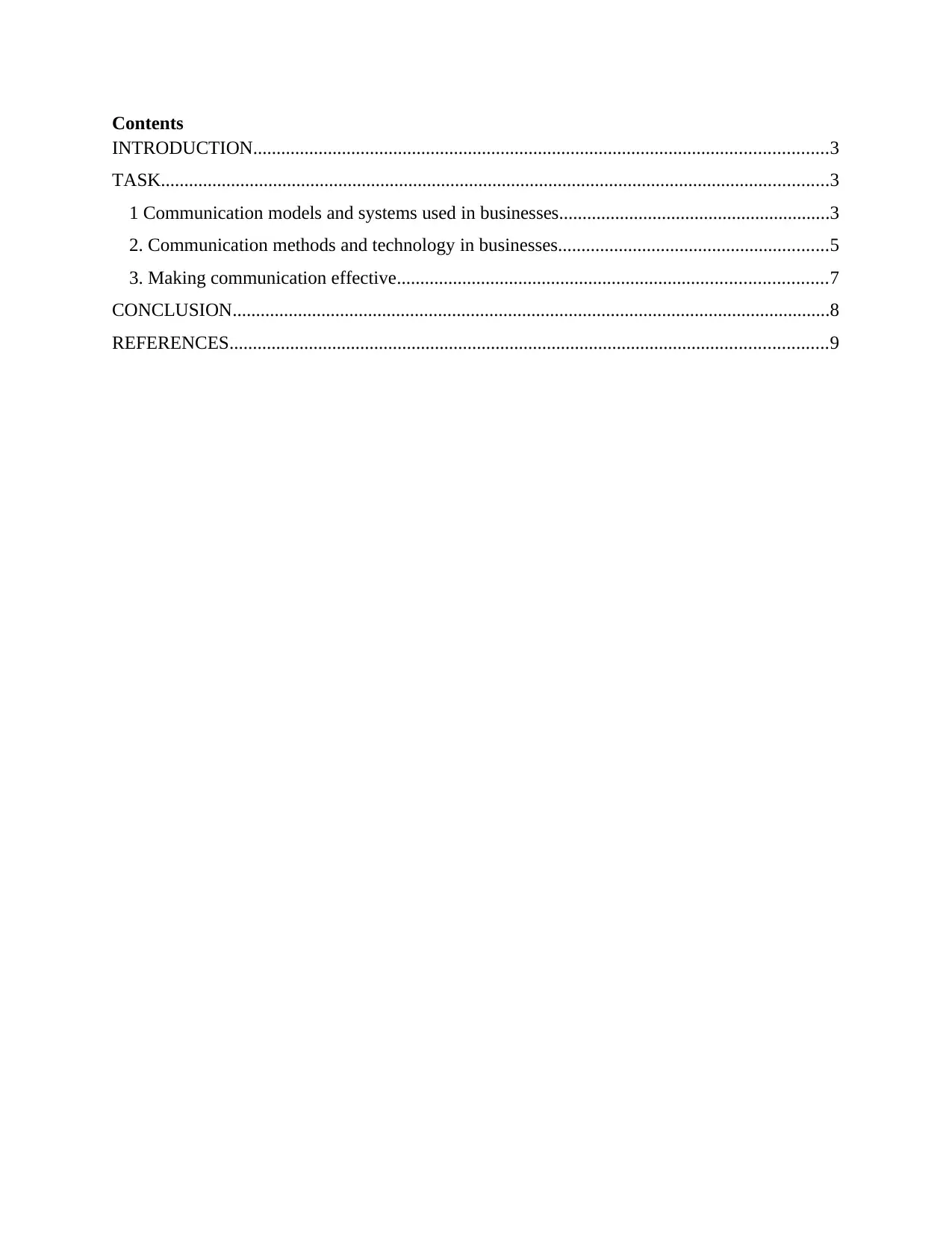
Contents
INTRODUCTION...........................................................................................................................3
TASK...............................................................................................................................................3
1 Communication models and systems used in businesses..........................................................3
2. Communication methods and technology in businesses..........................................................5
3. Making communication effective............................................................................................7
CONCLUSION................................................................................................................................8
REFERENCES................................................................................................................................9
INTRODUCTION...........................................................................................................................3
TASK...............................................................................................................................................3
1 Communication models and systems used in businesses..........................................................3
2. Communication methods and technology in businesses..........................................................5
3. Making communication effective............................................................................................7
CONCLUSION................................................................................................................................8
REFERENCES................................................................................................................................9
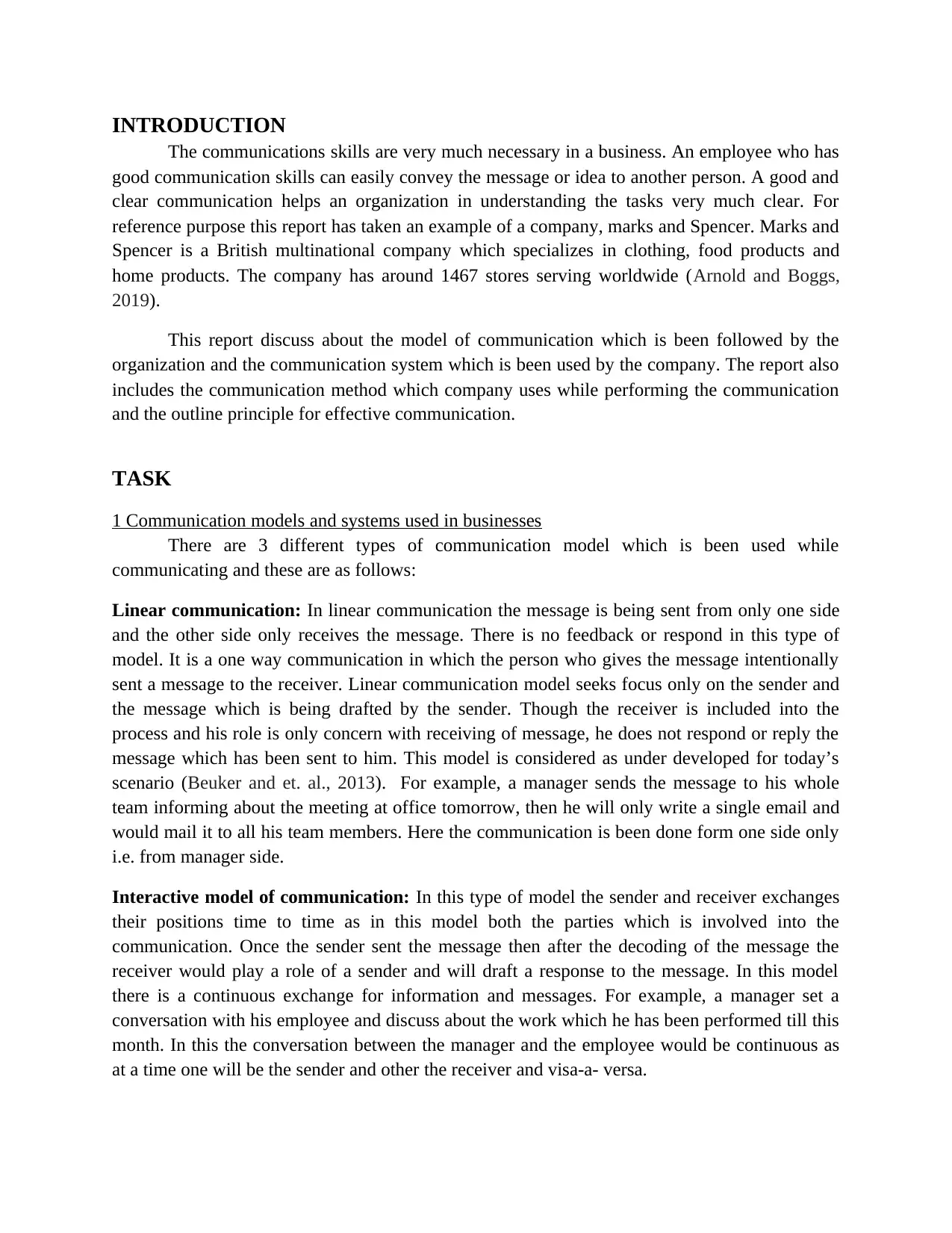
INTRODUCTION
The communications skills are very much necessary in a business. An employee who has
good communication skills can easily convey the message or idea to another person. A good and
clear communication helps an organization in understanding the tasks very much clear. For
reference purpose this report has taken an example of a company, marks and Spencer. Marks and
Spencer is a British multinational company which specializes in clothing, food products and
home products. The company has around 1467 stores serving worldwide (Arnold and Boggs,
2019).
This report discuss about the model of communication which is been followed by the
organization and the communication system which is been used by the company. The report also
includes the communication method which company uses while performing the communication
and the outline principle for effective communication.
TASK
1 Communication models and systems used in businesses
There are 3 different types of communication model which is been used while
communicating and these are as follows:
Linear communication: In linear communication the message is being sent from only one side
and the other side only receives the message. There is no feedback or respond in this type of
model. It is a one way communication in which the person who gives the message intentionally
sent a message to the receiver. Linear communication model seeks focus only on the sender and
the message which is being drafted by the sender. Though the receiver is included into the
process and his role is only concern with receiving of message, he does not respond or reply the
message which has been sent to him. This model is considered as under developed for today’s
scenario (Beuker and et. al., 2013). For example, a manager sends the message to his whole
team informing about the meeting at office tomorrow, then he will only write a single email and
would mail it to all his team members. Here the communication is been done form one side only
i.e. from manager side.
Interactive model of communication: In this type of model the sender and receiver exchanges
their positions time to time as in this model both the parties which is involved into the
communication. Once the sender sent the message then after the decoding of the message the
receiver would play a role of a sender and will draft a response to the message. In this model
there is a continuous exchange for information and messages. For example, a manager set a
conversation with his employee and discuss about the work which he has been performed till this
month. In this the conversation between the manager and the employee would be continuous as
at a time one will be the sender and other the receiver and visa-a- versa.
The communications skills are very much necessary in a business. An employee who has
good communication skills can easily convey the message or idea to another person. A good and
clear communication helps an organization in understanding the tasks very much clear. For
reference purpose this report has taken an example of a company, marks and Spencer. Marks and
Spencer is a British multinational company which specializes in clothing, food products and
home products. The company has around 1467 stores serving worldwide (Arnold and Boggs,
2019).
This report discuss about the model of communication which is been followed by the
organization and the communication system which is been used by the company. The report also
includes the communication method which company uses while performing the communication
and the outline principle for effective communication.
TASK
1 Communication models and systems used in businesses
There are 3 different types of communication model which is been used while
communicating and these are as follows:
Linear communication: In linear communication the message is being sent from only one side
and the other side only receives the message. There is no feedback or respond in this type of
model. It is a one way communication in which the person who gives the message intentionally
sent a message to the receiver. Linear communication model seeks focus only on the sender and
the message which is being drafted by the sender. Though the receiver is included into the
process and his role is only concern with receiving of message, he does not respond or reply the
message which has been sent to him. This model is considered as under developed for today’s
scenario (Beuker and et. al., 2013). For example, a manager sends the message to his whole
team informing about the meeting at office tomorrow, then he will only write a single email and
would mail it to all his team members. Here the communication is been done form one side only
i.e. from manager side.
Interactive model of communication: In this type of model the sender and receiver exchanges
their positions time to time as in this model both the parties which is involved into the
communication. Once the sender sent the message then after the decoding of the message the
receiver would play a role of a sender and will draft a response to the message. In this model
there is a continuous exchange for information and messages. For example, a manager set a
conversation with his employee and discuss about the work which he has been performed till this
month. In this the conversation between the manager and the employee would be continuous as
at a time one will be the sender and other the receiver and visa-a- versa.
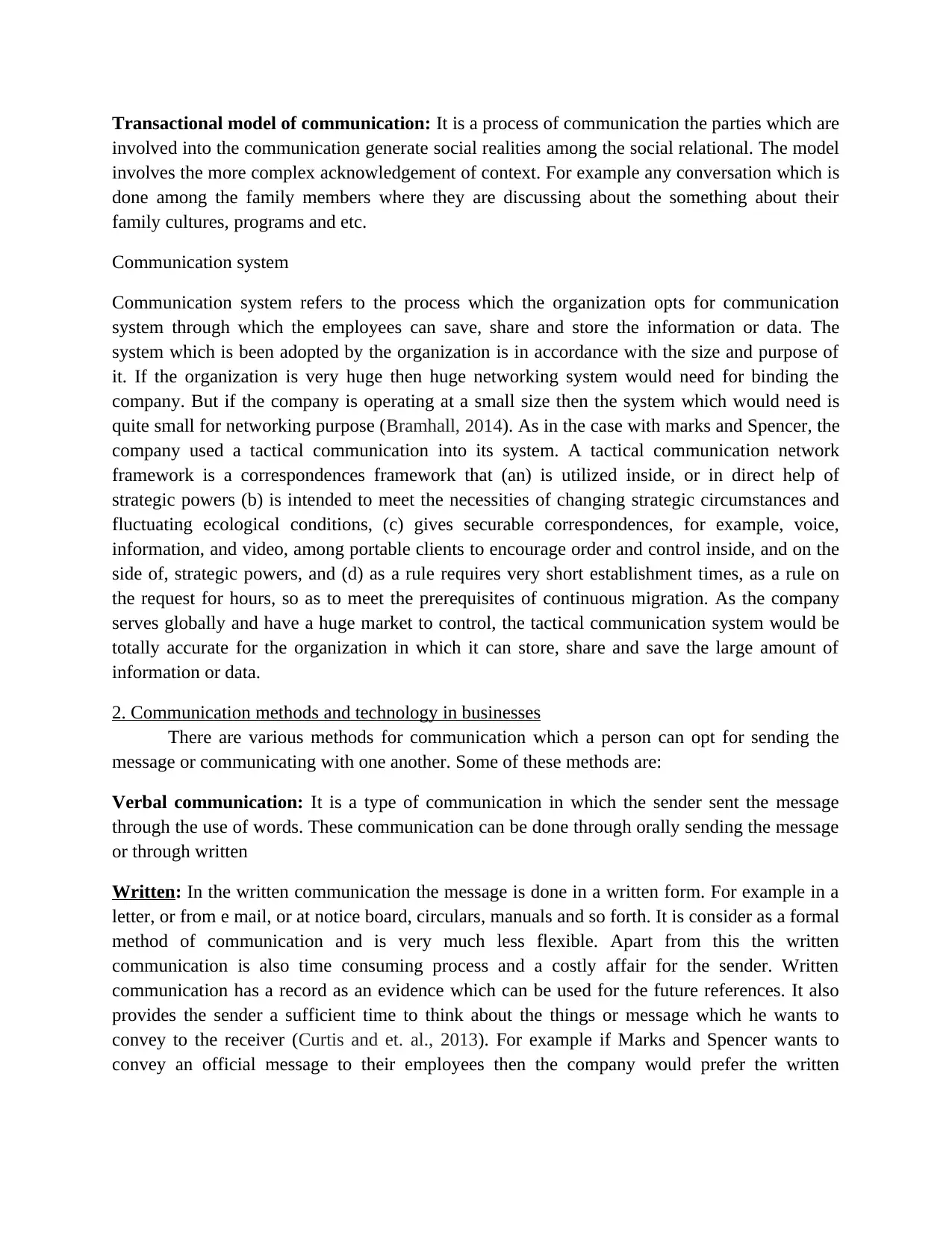
Transactional model of communication: It is a process of communication the parties which are
involved into the communication generate social realities among the social relational. The model
involves the more complex acknowledgement of context. For example any conversation which is
done among the family members where they are discussing about the something about their
family cultures, programs and etc.
Communication system
Communication system refers to the process which the organization opts for communication
system through which the employees can save, share and store the information or data. The
system which is been adopted by the organization is in accordance with the size and purpose of
it. If the organization is very huge then huge networking system would need for binding the
company. But if the company is operating at a small size then the system which would need is
quite small for networking purpose (Bramhall, 2014). As in the case with marks and Spencer, the
company used a tactical communication into its system. A tactical communication network
framework is a correspondences framework that (an) is utilized inside, or in direct help of
strategic powers (b) is intended to meet the necessities of changing strategic circumstances and
fluctuating ecological conditions, (c) gives securable correspondences, for example, voice,
information, and video, among portable clients to encourage order and control inside, and on the
side of, strategic powers, and (d) as a rule requires very short establishment times, as a rule on
the request for hours, so as to meet the prerequisites of continuous migration. As the company
serves globally and have a huge market to control, the tactical communication system would be
totally accurate for the organization in which it can store, share and save the large amount of
information or data.
2. Communication methods and technology in businesses
There are various methods for communication which a person can opt for sending the
message or communicating with one another. Some of these methods are:
Verbal communication: It is a type of communication in which the sender sent the message
through the use of words. These communication can be done through orally sending the message
or through written
Written: In the written communication the message is done in a written form. For example in a
letter, or from e mail, or at notice board, circulars, manuals and so forth. It is consider as a formal
method of communication and is very much less flexible. Apart from this the written
communication is also time consuming process and a costly affair for the sender. Written
communication has a record as an evidence which can be used for the future references. It also
provides the sender a sufficient time to think about the things or message which he wants to
convey to the receiver (Curtis and et. al., 2013). For example if Marks and Spencer wants to
convey an official message to their employees then the company would prefer the written
involved into the communication generate social realities among the social relational. The model
involves the more complex acknowledgement of context. For example any conversation which is
done among the family members where they are discussing about the something about their
family cultures, programs and etc.
Communication system
Communication system refers to the process which the organization opts for communication
system through which the employees can save, share and store the information or data. The
system which is been adopted by the organization is in accordance with the size and purpose of
it. If the organization is very huge then huge networking system would need for binding the
company. But if the company is operating at a small size then the system which would need is
quite small for networking purpose (Bramhall, 2014). As in the case with marks and Spencer, the
company used a tactical communication into its system. A tactical communication network
framework is a correspondences framework that (an) is utilized inside, or in direct help of
strategic powers (b) is intended to meet the necessities of changing strategic circumstances and
fluctuating ecological conditions, (c) gives securable correspondences, for example, voice,
information, and video, among portable clients to encourage order and control inside, and on the
side of, strategic powers, and (d) as a rule requires very short establishment times, as a rule on
the request for hours, so as to meet the prerequisites of continuous migration. As the company
serves globally and have a huge market to control, the tactical communication system would be
totally accurate for the organization in which it can store, share and save the large amount of
information or data.
2. Communication methods and technology in businesses
There are various methods for communication which a person can opt for sending the
message or communicating with one another. Some of these methods are:
Verbal communication: It is a type of communication in which the sender sent the message
through the use of words. These communication can be done through orally sending the message
or through written
Written: In the written communication the message is done in a written form. For example in a
letter, or from e mail, or at notice board, circulars, manuals and so forth. It is consider as a formal
method of communication and is very much less flexible. Apart from this the written
communication is also time consuming process and a costly affair for the sender. Written
communication has a record as an evidence which can be used for the future references. It also
provides the sender a sufficient time to think about the things or message which he wants to
convey to the receiver (Curtis and et. al., 2013). For example if Marks and Spencer wants to
convey an official message to their employees then the company would prefer the written
Secure Best Marks with AI Grader
Need help grading? Try our AI Grader for instant feedback on your assignments.
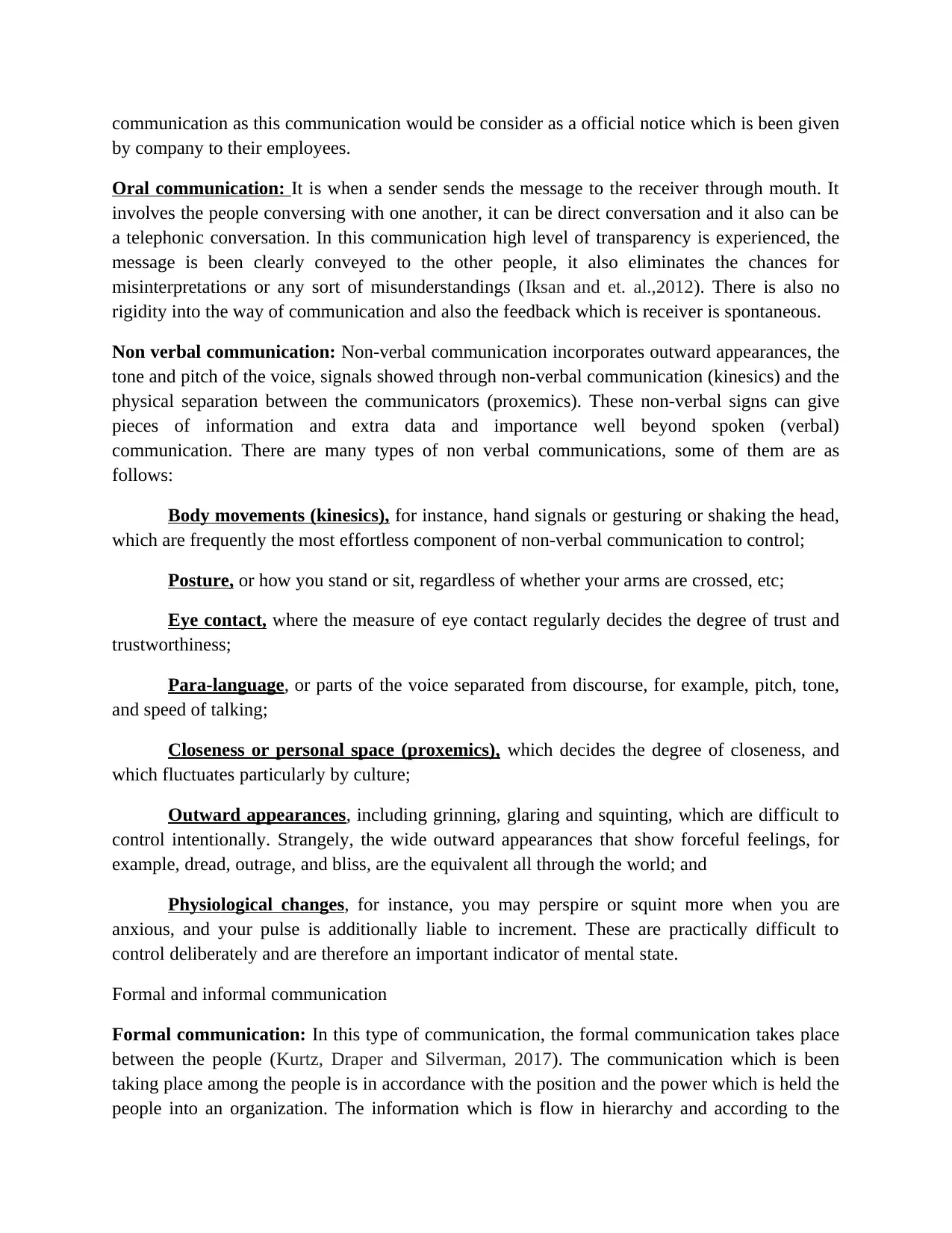
communication as this communication would be consider as a official notice which is been given
by company to their employees.
Oral communication: It is when a sender sends the message to the receiver through mouth. It
involves the people conversing with one another, it can be direct conversation and it also can be
a telephonic conversation. In this communication high level of transparency is experienced, the
message is been clearly conveyed to the other people, it also eliminates the chances for
misinterpretations or any sort of misunderstandings (Iksan and et. al.,2012). There is also no
rigidity into the way of communication and also the feedback which is receiver is spontaneous.
Non verbal communication: Non-verbal communication incorporates outward appearances, the
tone and pitch of the voice, signals showed through non-verbal communication (kinesics) and the
physical separation between the communicators (proxemics). These non-verbal signs can give
pieces of information and extra data and importance well beyond spoken (verbal)
communication. There are many types of non verbal communications, some of them are as
follows:
Body movements (kinesics), for instance, hand signals or gesturing or shaking the head,
which are frequently the most effortless component of non-verbal communication to control;
Posture, or how you stand or sit, regardless of whether your arms are crossed, etc;
Eye contact, where the measure of eye contact regularly decides the degree of trust and
trustworthiness;
Para-language, or parts of the voice separated from discourse, for example, pitch, tone,
and speed of talking;
Closeness or personal space (proxemics), which decides the degree of closeness, and
which fluctuates particularly by culture;
Outward appearances, including grinning, glaring and squinting, which are difficult to
control intentionally. Strangely, the wide outward appearances that show forceful feelings, for
example, dread, outrage, and bliss, are the equivalent all through the world; and
Physiological changes, for instance, you may perspire or squint more when you are
anxious, and your pulse is additionally liable to increment. These are practically difficult to
control deliberately and are therefore an important indicator of mental state.
Formal and informal communication
Formal communication: In this type of communication, the formal communication takes place
between the people (Kurtz, Draper and Silverman, 2017). The communication which is been
taking place among the people is in accordance with the position and the power which is held the
people into an organization. The information which is flow in hierarchy and according to the
by company to their employees.
Oral communication: It is when a sender sends the message to the receiver through mouth. It
involves the people conversing with one another, it can be direct conversation and it also can be
a telephonic conversation. In this communication high level of transparency is experienced, the
message is been clearly conveyed to the other people, it also eliminates the chances for
misinterpretations or any sort of misunderstandings (Iksan and et. al.,2012). There is also no
rigidity into the way of communication and also the feedback which is receiver is spontaneous.
Non verbal communication: Non-verbal communication incorporates outward appearances, the
tone and pitch of the voice, signals showed through non-verbal communication (kinesics) and the
physical separation between the communicators (proxemics). These non-verbal signs can give
pieces of information and extra data and importance well beyond spoken (verbal)
communication. There are many types of non verbal communications, some of them are as
follows:
Body movements (kinesics), for instance, hand signals or gesturing or shaking the head,
which are frequently the most effortless component of non-verbal communication to control;
Posture, or how you stand or sit, regardless of whether your arms are crossed, etc;
Eye contact, where the measure of eye contact regularly decides the degree of trust and
trustworthiness;
Para-language, or parts of the voice separated from discourse, for example, pitch, tone,
and speed of talking;
Closeness or personal space (proxemics), which decides the degree of closeness, and
which fluctuates particularly by culture;
Outward appearances, including grinning, glaring and squinting, which are difficult to
control intentionally. Strangely, the wide outward appearances that show forceful feelings, for
example, dread, outrage, and bliss, are the equivalent all through the world; and
Physiological changes, for instance, you may perspire or squint more when you are
anxious, and your pulse is additionally liable to increment. These are practically difficult to
control deliberately and are therefore an important indicator of mental state.
Formal and informal communication
Formal communication: In this type of communication, the formal communication takes place
between the people (Kurtz, Draper and Silverman, 2017). The communication which is been
taking place among the people is in accordance with the position and the power which is held the
people into an organization. The information which is flow in hierarchy and according to the
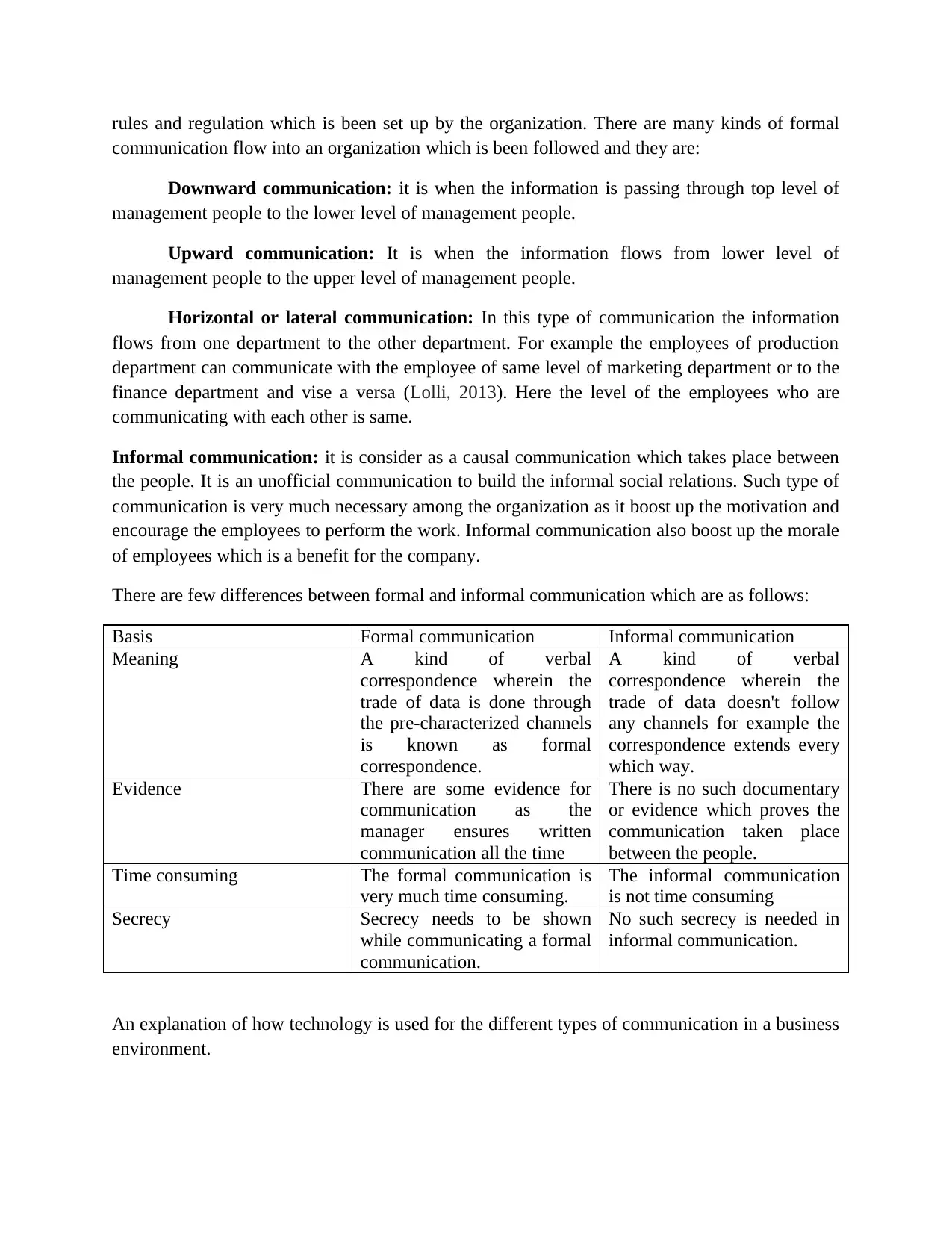
rules and regulation which is been set up by the organization. There are many kinds of formal
communication flow into an organization which is been followed and they are:
Downward communication: it is when the information is passing through top level of
management people to the lower level of management people.
Upward communication: It is when the information flows from lower level of
management people to the upper level of management people.
Horizontal or lateral communication: In this type of communication the information
flows from one department to the other department. For example the employees of production
department can communicate with the employee of same level of marketing department or to the
finance department and vise a versa (Lolli, 2013). Here the level of the employees who are
communicating with each other is same.
Informal communication: it is consider as a causal communication which takes place between
the people. It is an unofficial communication to build the informal social relations. Such type of
communication is very much necessary among the organization as it boost up the motivation and
encourage the employees to perform the work. Informal communication also boost up the morale
of employees which is a benefit for the company.
There are few differences between formal and informal communication which are as follows:
Basis Formal communication Informal communication
Meaning A kind of verbal
correspondence wherein the
trade of data is done through
the pre-characterized channels
is known as formal
correspondence.
A kind of verbal
correspondence wherein the
trade of data doesn't follow
any channels for example the
correspondence extends every
which way.
Evidence There are some evidence for
communication as the
manager ensures written
communication all the time
There is no such documentary
or evidence which proves the
communication taken place
between the people.
Time consuming The formal communication is
very much time consuming.
The informal communication
is not time consuming
Secrecy Secrecy needs to be shown
while communicating a formal
communication.
No such secrecy is needed in
informal communication.
An explanation of how technology is used for the different types of communication in a business
environment.
communication flow into an organization which is been followed and they are:
Downward communication: it is when the information is passing through top level of
management people to the lower level of management people.
Upward communication: It is when the information flows from lower level of
management people to the upper level of management people.
Horizontal or lateral communication: In this type of communication the information
flows from one department to the other department. For example the employees of production
department can communicate with the employee of same level of marketing department or to the
finance department and vise a versa (Lolli, 2013). Here the level of the employees who are
communicating with each other is same.
Informal communication: it is consider as a causal communication which takes place between
the people. It is an unofficial communication to build the informal social relations. Such type of
communication is very much necessary among the organization as it boost up the motivation and
encourage the employees to perform the work. Informal communication also boost up the morale
of employees which is a benefit for the company.
There are few differences between formal and informal communication which are as follows:
Basis Formal communication Informal communication
Meaning A kind of verbal
correspondence wherein the
trade of data is done through
the pre-characterized channels
is known as formal
correspondence.
A kind of verbal
correspondence wherein the
trade of data doesn't follow
any channels for example the
correspondence extends every
which way.
Evidence There are some evidence for
communication as the
manager ensures written
communication all the time
There is no such documentary
or evidence which proves the
communication taken place
between the people.
Time consuming The formal communication is
very much time consuming.
The informal communication
is not time consuming
Secrecy Secrecy needs to be shown
while communicating a formal
communication.
No such secrecy is needed in
informal communication.
An explanation of how technology is used for the different types of communication in a business
environment.
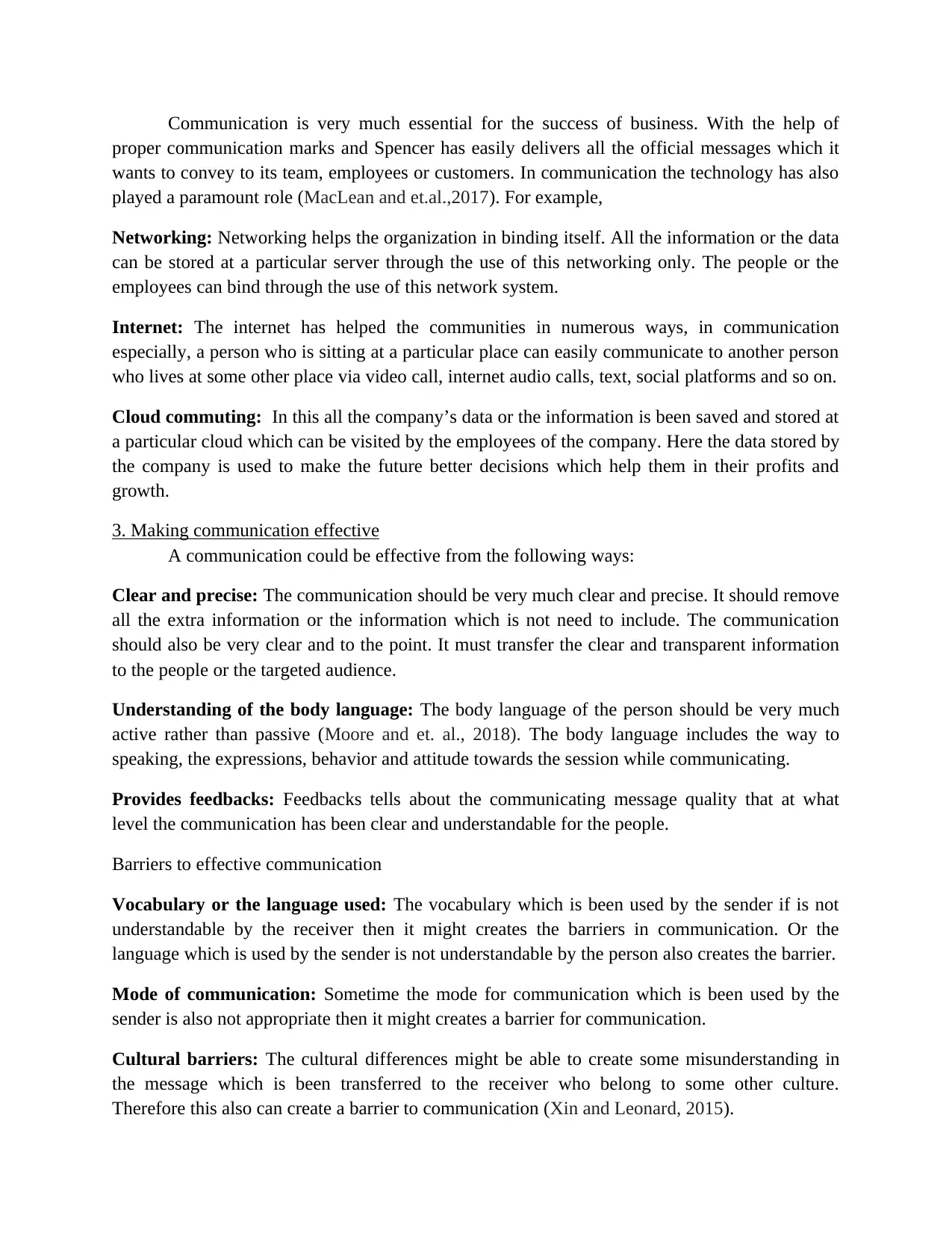
Communication is very much essential for the success of business. With the help of
proper communication marks and Spencer has easily delivers all the official messages which it
wants to convey to its team, employees or customers. In communication the technology has also
played a paramount role (MacLean and et.al.,2017). For example,
Networking: Networking helps the organization in binding itself. All the information or the data
can be stored at a particular server through the use of this networking only. The people or the
employees can bind through the use of this network system.
Internet: The internet has helped the communities in numerous ways, in communication
especially, a person who is sitting at a particular place can easily communicate to another person
who lives at some other place via video call, internet audio calls, text, social platforms and so on.
Cloud commuting: In this all the company’s data or the information is been saved and stored at
a particular cloud which can be visited by the employees of the company. Here the data stored by
the company is used to make the future better decisions which help them in their profits and
growth.
3. Making communication effective
A communication could be effective from the following ways:
Clear and precise: The communication should be very much clear and precise. It should remove
all the extra information or the information which is not need to include. The communication
should also be very clear and to the point. It must transfer the clear and transparent information
to the people or the targeted audience.
Understanding of the body language: The body language of the person should be very much
active rather than passive (Moore and et. al., 2018). The body language includes the way to
speaking, the expressions, behavior and attitude towards the session while communicating.
Provides feedbacks: Feedbacks tells about the communicating message quality that at what
level the communication has been clear and understandable for the people.
Barriers to effective communication
Vocabulary or the language used: The vocabulary which is been used by the sender if is not
understandable by the receiver then it might creates the barriers in communication. Or the
language which is used by the sender is not understandable by the person also creates the barrier.
Mode of communication: Sometime the mode for communication which is been used by the
sender is also not appropriate then it might creates a barrier for communication.
Cultural barriers: The cultural differences might be able to create some misunderstanding in
the message which is been transferred to the receiver who belong to some other culture.
Therefore this also can create a barrier to communication (Xin and Leonard, 2015).
proper communication marks and Spencer has easily delivers all the official messages which it
wants to convey to its team, employees or customers. In communication the technology has also
played a paramount role (MacLean and et.al.,2017). For example,
Networking: Networking helps the organization in binding itself. All the information or the data
can be stored at a particular server through the use of this networking only. The people or the
employees can bind through the use of this network system.
Internet: The internet has helped the communities in numerous ways, in communication
especially, a person who is sitting at a particular place can easily communicate to another person
who lives at some other place via video call, internet audio calls, text, social platforms and so on.
Cloud commuting: In this all the company’s data or the information is been saved and stored at
a particular cloud which can be visited by the employees of the company. Here the data stored by
the company is used to make the future better decisions which help them in their profits and
growth.
3. Making communication effective
A communication could be effective from the following ways:
Clear and precise: The communication should be very much clear and precise. It should remove
all the extra information or the information which is not need to include. The communication
should also be very clear and to the point. It must transfer the clear and transparent information
to the people or the targeted audience.
Understanding of the body language: The body language of the person should be very much
active rather than passive (Moore and et. al., 2018). The body language includes the way to
speaking, the expressions, behavior and attitude towards the session while communicating.
Provides feedbacks: Feedbacks tells about the communicating message quality that at what
level the communication has been clear and understandable for the people.
Barriers to effective communication
Vocabulary or the language used: The vocabulary which is been used by the sender if is not
understandable by the receiver then it might creates the barriers in communication. Or the
language which is used by the sender is not understandable by the person also creates the barrier.
Mode of communication: Sometime the mode for communication which is been used by the
sender is also not appropriate then it might creates a barrier for communication.
Cultural barriers: The cultural differences might be able to create some misunderstanding in
the message which is been transferred to the receiver who belong to some other culture.
Therefore this also can create a barrier to communication (Xin and Leonard, 2015).
Paraphrase This Document
Need a fresh take? Get an instant paraphrase of this document with our AI Paraphraser
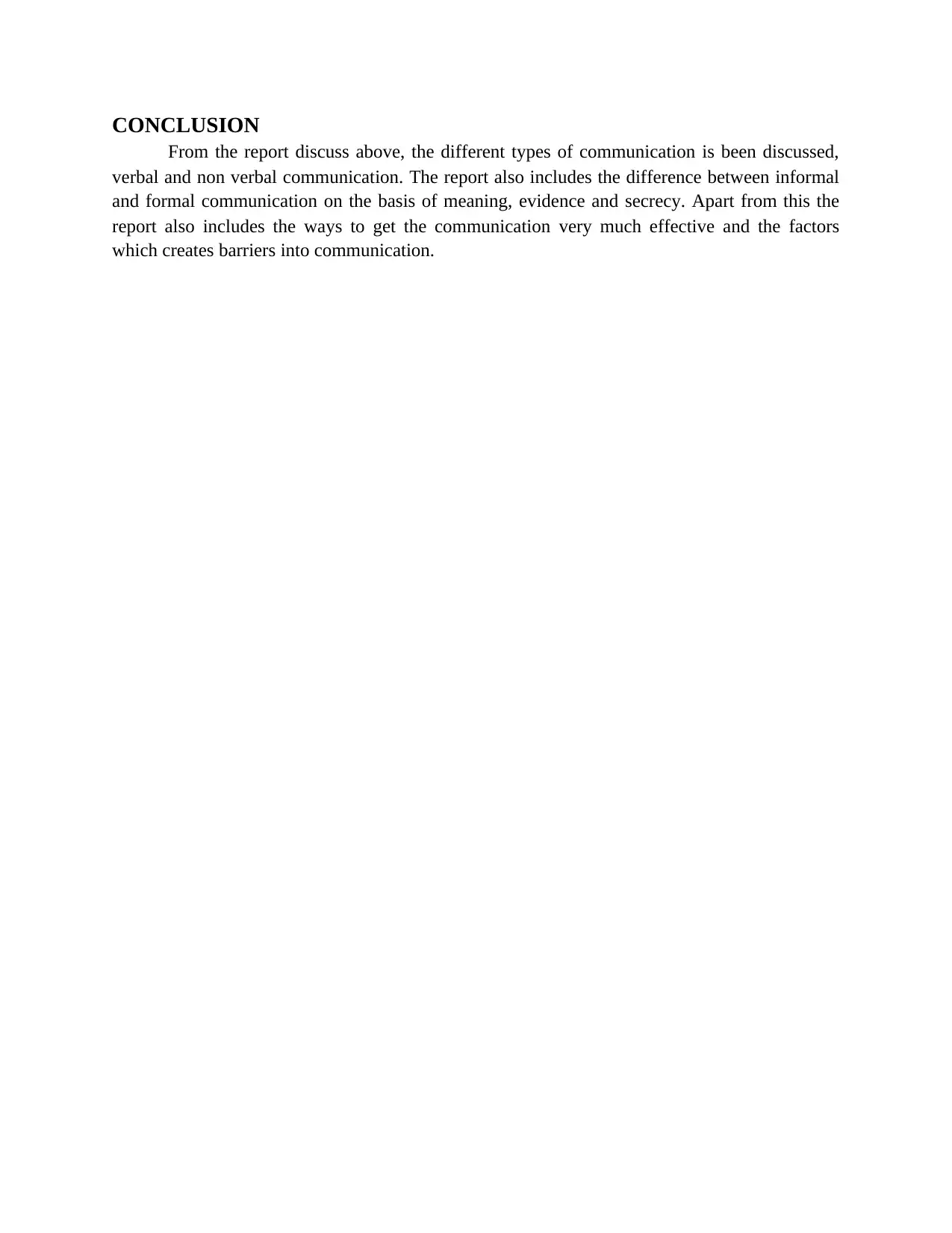
CONCLUSION
From the report discuss above, the different types of communication is been discussed,
verbal and non verbal communication. The report also includes the difference between informal
and formal communication on the basis of meaning, evidence and secrecy. Apart from this the
report also includes the ways to get the communication very much effective and the factors
which creates barriers into communication.
From the report discuss above, the different types of communication is been discussed,
verbal and non verbal communication. The report also includes the difference between informal
and formal communication on the basis of meaning, evidence and secrecy. Apart from this the
report also includes the ways to get the communication very much effective and the factors
which creates barriers into communication.
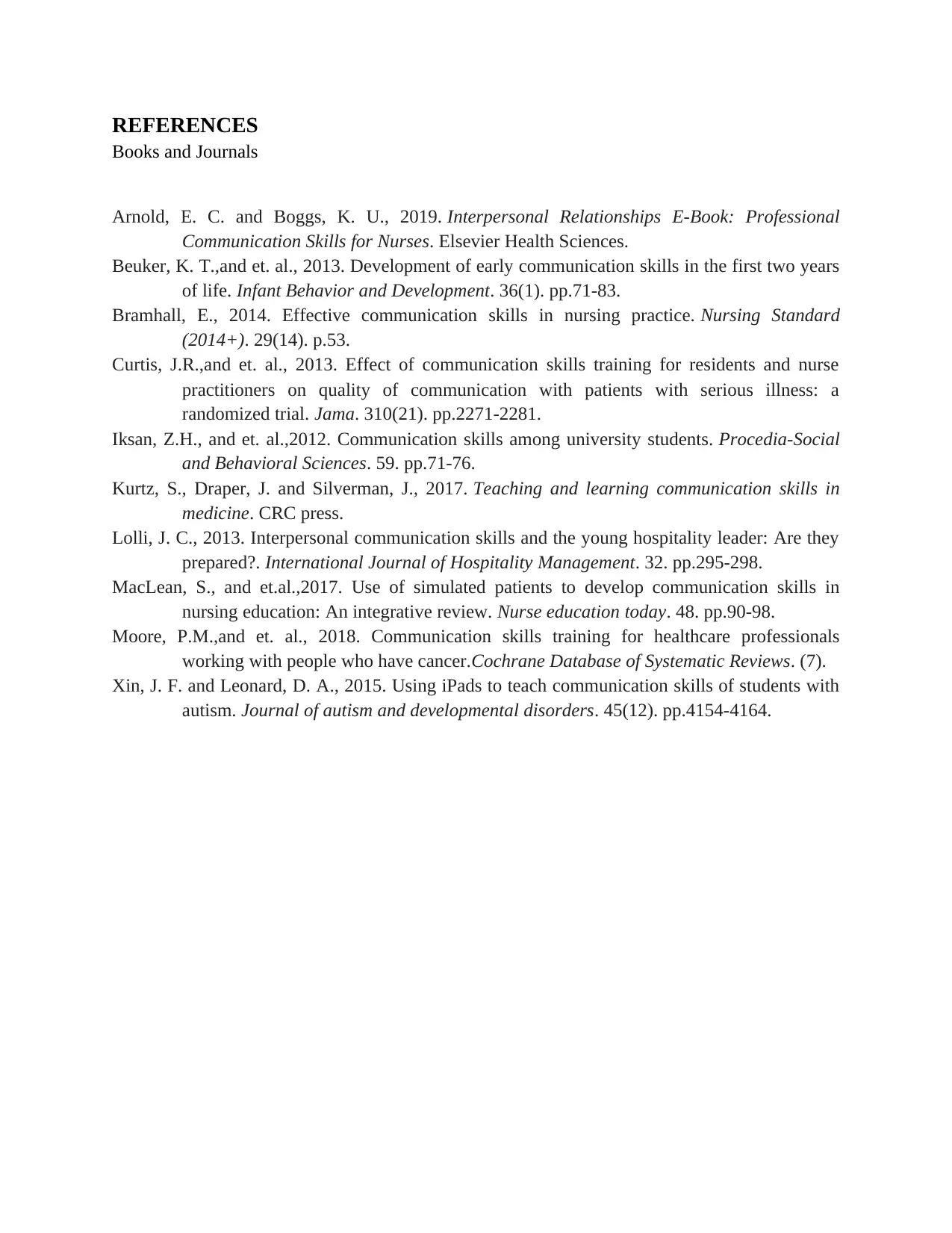
REFERENCES
Books and Journals
Arnold, E. C. and Boggs, K. U., 2019. Interpersonal Relationships E-Book: Professional
Communication Skills for Nurses. Elsevier Health Sciences.
Beuker, K. T.,and et. al., 2013. Development of early communication skills in the first two years
of life. Infant Behavior and Development. 36(1). pp.71-83.
Bramhall, E., 2014. Effective communication skills in nursing practice. Nursing Standard
(2014+). 29(14). p.53.
Curtis, J.R.,and et. al., 2013. Effect of communication skills training for residents and nurse
practitioners on quality of communication with patients with serious illness: a
randomized trial. Jama. 310(21). pp.2271-2281.
Iksan, Z.H., and et. al.,2012. Communication skills among university students. Procedia-Social
and Behavioral Sciences. 59. pp.71-76.
Kurtz, S., Draper, J. and Silverman, J., 2017. Teaching and learning communication skills in
medicine. CRC press.
Lolli, J. C., 2013. Interpersonal communication skills and the young hospitality leader: Are they
prepared?. International Journal of Hospitality Management. 32. pp.295-298.
MacLean, S., and et.al.,2017. Use of simulated patients to develop communication skills in
nursing education: An integrative review. Nurse education today. 48. pp.90-98.
Moore, P.M.,and et. al., 2018. Communication skills training for healthcare professionals
working with people who have cancer.Cochrane Database of Systematic Reviews. (7).
Xin, J. F. and Leonard, D. A., 2015. Using iPads to teach communication skills of students with
autism. Journal of autism and developmental disorders. 45(12). pp.4154-4164.
Books and Journals
Arnold, E. C. and Boggs, K. U., 2019. Interpersonal Relationships E-Book: Professional
Communication Skills for Nurses. Elsevier Health Sciences.
Beuker, K. T.,and et. al., 2013. Development of early communication skills in the first two years
of life. Infant Behavior and Development. 36(1). pp.71-83.
Bramhall, E., 2014. Effective communication skills in nursing practice. Nursing Standard
(2014+). 29(14). p.53.
Curtis, J.R.,and et. al., 2013. Effect of communication skills training for residents and nurse
practitioners on quality of communication with patients with serious illness: a
randomized trial. Jama. 310(21). pp.2271-2281.
Iksan, Z.H., and et. al.,2012. Communication skills among university students. Procedia-Social
and Behavioral Sciences. 59. pp.71-76.
Kurtz, S., Draper, J. and Silverman, J., 2017. Teaching and learning communication skills in
medicine. CRC press.
Lolli, J. C., 2013. Interpersonal communication skills and the young hospitality leader: Are they
prepared?. International Journal of Hospitality Management. 32. pp.295-298.
MacLean, S., and et.al.,2017. Use of simulated patients to develop communication skills in
nursing education: An integrative review. Nurse education today. 48. pp.90-98.
Moore, P.M.,and et. al., 2018. Communication skills training for healthcare professionals
working with people who have cancer.Cochrane Database of Systematic Reviews. (7).
Xin, J. F. and Leonard, D. A., 2015. Using iPads to teach communication skills of students with
autism. Journal of autism and developmental disorders. 45(12). pp.4154-4164.
1 out of 9
Related Documents
Your All-in-One AI-Powered Toolkit for Academic Success.
+13062052269
info@desklib.com
Available 24*7 on WhatsApp / Email
![[object Object]](/_next/static/media/star-bottom.7253800d.svg)
Unlock your academic potential
© 2024 | Zucol Services PVT LTD | All rights reserved.




